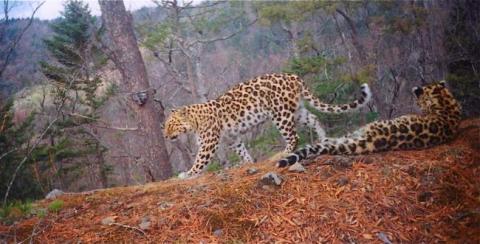Russia to the Rescue of Leopards and Tigers
On April 9th, the government of Russia created a new national park that bestows globally significant protection on the world’s rarest big cat: the Far Eastern leopard, as well as the critically endangered Siberian tigers.
“Land of the Leopard” National Park, sequesters 1,011 square miles (262,000 hectares) of tiger and leopard habitat in Russia’s Far East. The park protects newly designated land along the Chinese border (the northeast portion of the leopard’s range), as well as includes the pre-existing preserves of Kedrovya Pad, the Borisovkoe Plateau Regional Wildlife Refuge, and the Barsovy Federal Wildlife Refuge.
A news release from the Wildlife Conservation Society, which applauded the Russian government action, said, “The last 30 or so remaining Far Eastern leopards occur in a narrow sliver of Russian forests between the Sea of Japan ... and Jilin Province, China. While tigers occur over a much broader region to the north, this Southwest region of Primorskii Krai also retains a vital yet small population that regularly move across the border into Hunchun Reserve China, and thus represent a critical source population for recovery of tigers in Northeast China.”
The critically endangered Far Eastern leopard (Panthera pardus orientalis) is estimated to have a total population of only 40 to 50 individuals. One commentator called them, “teetering on the edge of extinction.”
Scientific American said about 12 of the animals live in adjacent China where there are two nature preserves in the area. The World Wildlife Fund is hoping for cross-border cooperation. The Wildlife Conservation Society said, it “has been providing assistance to the Russian Government to conserve Amur (Siberian) tigers and Far Eastern leopards since 1993. WCS is working on a suite of initiatives in the protected area and surrounding regions include long-term population monitoring of tigers, leopards, and prey species, law enforcement training and monitoring, a fire protection program, radio telemetry studies, mentoring Russian graduate students who are researching the big cats, and health studies of both leopards and tigers.”
In a blog on Scientific American.com, John R. Platt said, “The Russian government will invest $16.6 million toward developing the park, which will include protected areas for wildlife, an economic development zone and an ecotourism recreational zone. Russia has also committed an additional $1.3 million for upkeep of the park.”
“This is tremendous news for big cat conservation,” said Peter Zahler, Wildlife Conservation Society Deputy Director for Asia. “The creation of this park greatly increases the amount of land protecting critical populations of two of the world’s big cats, and it will go a long way to securing their future.”
The Wildlife Conservation Society urges supporters of their efforts to protect these species to visit their website “where they can donate to support saving wildlife and wild places.”
History of Trail Stiles May Hobble Easier Access in UK
Improving visitor access is sparking discussion in England’s Dartmoor National Park.
Articles in newspapers predict that the park’s 450 miles of trails will eventually see a reduction in the number of fence and hedge crossing stiles that require people to climb up and over.
The discussion ranges from the difficulties families face in crossing the obstacles with baby conveyances to the claim that even many dedicated walkers are just becoming too fat to be stepping up and down. An earlier report from the the Dartmoor National Park Authority highlighted the issue but efforts to improve access and create “less restrictive” crossing structures won’t be mandatory.
The Ordnance Survey says, “The changes have been unanimously approved, thus will become policy. Where changes can be made, it is likely that those out walking will pass through plain gaps or gates where livestock is situated.” Ordnance Survey produces the topographic maps that most hikers find indispensable in Dartmoor and throughout the United Kingdom.
In other locations, “structures which are distinctive or have local historic interest will be balanced against the needs of people with limited mobility when taking the decision,” said the Daily Mail, the United Kingdom's second biggest-selling daily newspaper.
The Dartmoor National Park Authority has a variety of solutions in mind and "will normally cover the costs but if a landowner chooses another option they will have to pay."
The Daily Mail says, “Gaps will be the preferred option, but gates will also be acceptable where livestock control is an issue.” The Ordnance Survey magazine says “some landowners are worried about the use - or misuse of gates. Ed Williams, director of Dartmoor Farmers' Association highlighted concerns that gates could be left open, allowing livestock to escape. ‘A stile can never be left open and livestock can never get through them - gates are the opposite.’”
The Mail said, “They have been a feature of the rugged landscape for centuries,” and reported that, “Many people will be sad to see the removal of Dartmoor's stiles, which ... have been recognised as a 'top countryside icon' in a poll by the Campaign to Protect Rural England.”
The Daily Mail said, “Campaigners claim the measures will make it easier for overweight adults to enjoy Dartmoor,” but a “spokesman for Dartmoor National Park insisted that the changes suggested in its report were not aimed at overweight individuals.”
Ian Johnson, south-west spokesman for the National Farmers’ Union, said: "'Anything which assists access and makes it easier for people to get into the countryside is better, as long as measures are in place to restrict the movement of livestock. It’s all about the balance.'"
Vice chairman of the Devon Senior Voice, 86-year-old Yvonne Wardrop, said stiles are a nuisance to a wide range of people of all ages but that any replacements had to be carefully thought out. "'The authority will have to think very carefully, not just about the people who need to use these facilities, but why there’s a border there in the first place.'"




Add comment